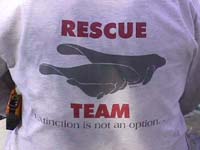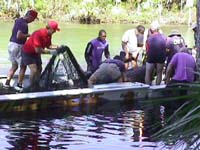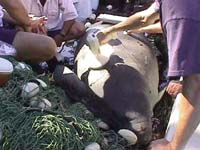 |
||||||||||||||||
Last night we got a call from the U.S. Fish and Wildlife Refuge office. They were doing a rescue of two manatees in Homasassa River, just south of Crystal River. We were invited to participate and show all of you what happens on a manatee rescue. We were really excited because rescues don't happen very often and we were going to be a part of it! 9:15 AM - We arrive at Homasassa River and meet some of the rescuers who are setting up. We see Mrs. Butler again and meet her boss, Mr. Bob Bonde, the chief scientist and director of the Sirenia Project. They tell us that they will be rescuing, not two but three manatees. One manatee is an adult that has a punctured lung. The punctured lung has filled with pus. (Manatees have two lungs like you do. Mantatee are heavy animals with large heavy bones. Manatees don't have the blubber that helps whales float. Manatees' large lungs give them buoyancy to help them float Without their lungs manatees would sink.) The manatee only has one good lung, and the manatee is weakening. When this manatee swims up to take a breathe it quickly drops back down to the bottom again! This manatee has to work harder to come to the surface to breathe. If the manatee does not get proper medical attention it will die. The manatee rescuers are here now to make sure that doesn't happen. They will capture this manatee, take it out of the water and to Lowry Park Zoo in Tampa, Florida. At the zoo this manatee can receive medical treatment. This manatee will released if it heals completely. If it doesn't heal completely, then this manatee will remain in the zoo to be taken care of. The other two manatees are a mother and calf. Actually the calf is the sick one, but we don't want to separate the mother and baby, so we will bring in the mother and calf together. While we have the mother and calf, we will take measurements,blood samples, skin samples, treat their propeller cuts, and even insert a very tiny (size of a grain of rice) electronic identification tag, just under their skin. With this tag scientists can quiickly and easily identify every manatee that has a tag. On Tuesday, Mr. Bonde, Mrs. Butler and Mr. Easton put radio transmitter tags on the injured adult and the calf's mother, so we could find them easily today. 11 AM - The team and all the boats are ready. They will rescue the injured adult first. One of the team has found it and the special manatee rescue boat goes off the recover it. To rescue the manatee, the scientists drop a large fishing-type net into the water around the manatee. Then they pull in the net toward the boat and pull the manatee onto the boat. This is not as easy as it sounds.We are trying to haul a 900 kg. animal onto the boat! Fortunately this rescue goes quickly, and by 11:30 this manatee has been rescued, and is on his way to the Lowry Zoo. (The manatee rides in an a moving van type vehicle. Foam padding is wedged in aroung the manatee and wet cotton bedspreads cover the manatee to make it all wet, comfy and cozy.) While the transfer from the boat to the van was going on I went out on my kayak to find the mother and calf. Mrs. Easton is out on a canoe with a research assistant to find the mother and calf. The radio transmitter tags stick out of the water, so the mother was easily found. I get in the water to make sure the calf is with the mother, so we can haul out both at the same time. NOON - The rescuers and boats are back and now they are ready to bring in the mother and calf. This rescue also is successful and quick. With the two rescue boats tied stern to stern we bring the mother and calf close to shore (about 1 meter deep) so the scientists and work from the boats or stand in shallow water next to the boats. The tests and treatments take about two hours to complete. Fortunately there are no serious problems or injuries with the mother and calf. After everything is completed it is time to release the mother and calf. Before we release them Mr. Bonde and Mrs. Easton put radio transmitter tags on them, so they can find them for future check-ups. |
One of our rescue team members...
Manatee rescue boats tied with sterns together. Manatee calf is in the net. Mother manatee is to the right of the rescuer bending over.
Scientist is holding an electronic scanner to check for an electronic ID tag under the mother's skin. (She did not have a tag, so the tags were inserted under her skin and her baby's.) PHOTOS TAKEN SO FAR |
|||||||||||||||
home | basecamp | archives | library | kids' page | teacher's link other expeditions | kids' page | contact us © 2001, The Ocean Adventure All rights reserved. |


